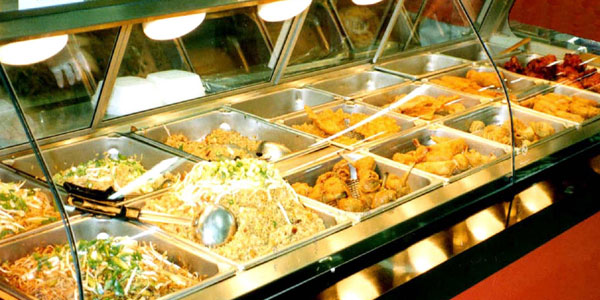
By Calvin
The Montreal Gazette published an article in November about “vintage Chinese restaurants” in that city, meaning the “dying breed” of restaurants that served Canadian Chinese cuisine. These days, writing on Westernized Chinese food (see my review of Banquet and The Fortune Cookie Chronicles for some good book-length examples) often points out how foreign this cuisine is to Chinese people:
“When I first saw the menu, I was like, ‘What’s that? And what’s that?’ I was really curious,” he recalls. “Everything was sweet and sour, everything was battered and fried, tastes that in China we don’t do so much.”
New cooks coming from China had to be taught the fundamentals of Can-Chi cuisine, he says. “Like chicken balls with cherry sauce; you just don’t see this in original Chinese food. It was made for Western people. We prefer steamed and stir-fried foods, and to taste the actual flavour of the ingredients.”
Taste the actual flavour of the ingredients? That’s revolutionary.
My dad has a nickname for Westernized Chinese food: aak gwai lo tsaan (呃鬼佬餐), Cantonese for “food for swindling white people [into thinking that this is what Chinese people actually eat].” This moniker pretty much sums up my family’s attitudes towards this type of food. Living in the San Gabriel Valley, one of the top places to go in North America for “authentic” Chinese and Vietnamese food, we never went to Americanized Chinese restaurants (of which there were very few, usually situated next to Wal-Marts or Mexican supermarkets). Why would you, when you have hundreds and hundreds of “real” Chinese restaurants to choose from?
I remember being very intrigued the first time I had Americanized Chinese food. We were somewhere in northern New Jersey, on the first day of our bus tour of the eastern US and Canada. My parents insisted on vacationing with a Chinese tour group, and since the tour company figured that the Chinese are about as unwilling to expand their culinary horizons as mainstream Americans are, they dropped us off at all-you-can-eat buffets serving American/Canadian Chinese food almost every day. The only change was when we stopped in Toronto and Montreal, where there were “real” Chinese restaurants to be found.
Having only read about Americanized Chinese cuisine in books and seen it on TV, dishes like moo shu pork and crab Rangoon were possibly more exotic to 14-year-old me than to your average mainstream American. So many fanciful names! So many different shades of brown! This jade-dragon-subgum-wonton stuff is what the rest of America thinks is Chinese food? I was amazed… until I started eating.
I was primed to expect something horrific, and horrific it was. The food tasted like a farcical imitation of “real” Chinese food, a culinary caricature made by overemphasizing the most pronounced flavors and covering them all in MSG, grease, and corn syrup. My taste buds were the first to revolt against this explosion of sugar and fat; soon afterwards, my stomach joined the protest. I never wanted to eat this type of food ever again.
Only after moving to small-town Pennsylvania for college did I begin to develop a taste for Americanized Chinese food. I became re-acquainted with this cuisine that I rejected, mostly because there weren’t too many other dining options in the tiny borough of Swarthmore, and pizza gets old very fast. Eventually, I discovered that I actually like this stuff. The food is so familiar and yet so unfamiliar at the same time. It’s a new cultural experience, but one that’s familiar enough to (excuse the pun) digest with ease. I came to love dishes like moo goo gai pan and beef with broccoli, which remind me of my mother’s cooking, except with the much heavier sauces that Americans have come to expect. I haven’t had General Tso’s chicken, egg foo young, or chop suey yet, but those are at the top of the list of things to try the next time I order delivery.
As my relationship with Americanized Chinese food changed, I started to realize that Westernized Chinese food isn’t a pale, gloopy imitation of “real” Chinese food, but rather a cuisine in and of itself. Westernized Chinese food is a lot like Westernized Chinese people, created out of cultural encounters and the negotiations that followed. On the surface, it looks like the food indigenous to China, but it is definitely much more at home here in the West, being made with Western ingredients and according to Western preferences.
Purists may decry that it’s not “real” Chinese food, but what is real Chinese food, anyway? Is there some sort of ancient recipe canon, saying that this is how Chinese food should be? Saying that there is a difference between “authentic” food and “inauthentic” food is denying wonderful cultural mixes like Westernized Chinese food and Westernized Chinese people.
ABOUT THE AUTHOR: Calvin N. Ho is a graduate student in sociology at UCLA, where he studies race, ethnicity, nationalism, and immigration. He has discovered that only non-Asians find it interesting that his hobby is eating around town and taking pictures of everything.
- Excited
- Fascinated
- Amused
- Disgusted
- Sad
- Angry








